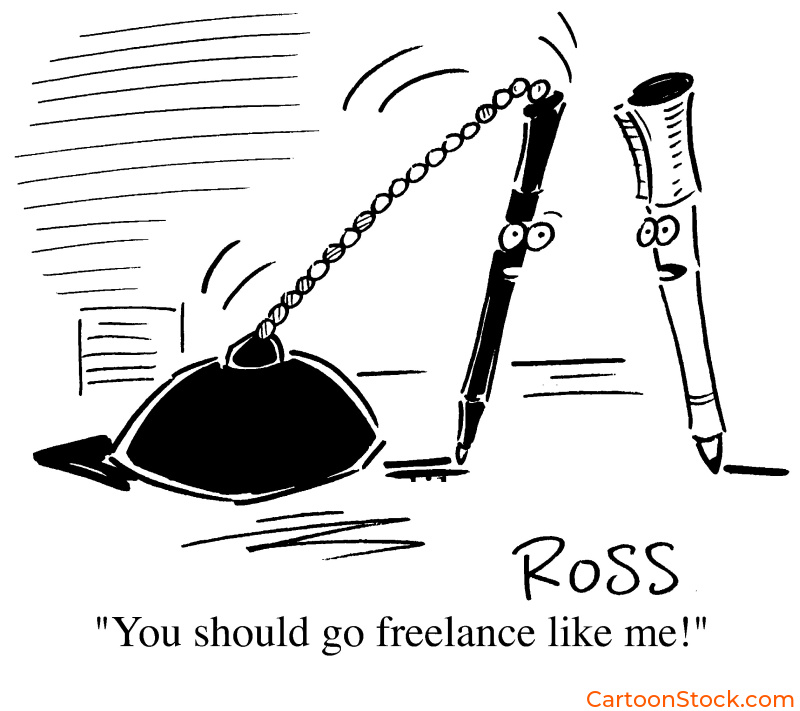There was a time when every major newspaper had its own staff cartoonist, a familiar name that readers saw every morning alongside the editorials. Today, most editorial cartoonists work as freelancers, selling to multiple outlets instead of drawing for one. The contrast between a freelance vs. staff cartoonist career has never been sharper — and never more relevant.
Both paths offer creative rewards, but their economics, rights, and stability differ dramatically. Here’s how each model works, what it means for cartoonists and editors, and how platforms like CartoonStock help bridge the gap between independence and opportunity.
For more information on a wider range of topics see our full guide -> The Complete Guide to Editorial Cartoons in Publishing
From the Newsroom Desk to the Home Studio
Staff cartoonists once enjoyed rare privileges in journalism: a secure salary, editorial freedom, and a loyal readership. But as newsroom budgets tightened, many publications reduced or eliminated these full-time positions.
Freelance cartoonists stepped in to fill the gap — supplying topical cartoons to multiple outlets, selling reprint rights, and licensing their back catalogues. The freelance vs. staff cartoonist transition mirrors a broader shift in creative industries: stability has given way to flexibility, but opportunity has multiplied.
The Economics of Staff vs. Freelance Cartooning
| Aspect | Staff Cartoonist | Freelance Cartoonist |
|---|---|---|
| Income Model | Salary (often with benefits) | Per-piece payment + licensing royalties |
| Creative Control | Guided by editorial stance | Full autonomy |
| Exposure | One consistent readership | Multiple outlets and audiences |
| Rights Ownership | Usually retained by employer | Retained by artist (varies by contract) |
| Workload | Regular, deadline-driven | Variable and project-based |
The freelance model offers creative freedom but less predictability. Its main advantage? Ownership. Freelancers can license and resell their work — something staff artists often can’t.
Licensing: The Freelance Advantage
Licensing has become a cornerstone of freelance sustainability. A single cartoon can generate income repeatedly when licensed for reprints, digital use, or educational content.
“By hosting your cartoons on a global licensing platform like CartoonStock, you retain your rights while reaching editors, publishers, and educators worldwide — no exclusivity or syndication required.”
That’s the freelance cartoonist’s economic advantage: one drawing, many paydays.
Building a Career as a Freelance vs. Staff Cartoonist
Success looks different for each path.
-
Staff cartoonists focus on building long-term relationships within one publication, shaping its editorial voice.
-
Freelancers build personal brands that cross borders, styles, and industries.
Whichever route you take, the key is consistency. Develop a recognisable tone, topic range, and visual style. Editors come back to artists whose work fits their publication’s identity — whether they’re on payroll or per piece.
How Editors Choose Between Staff and Freelance
Editors think practically.
-
Budget: Commissioning freelance cartoons can be more cost-effective than hiring in-house.
-
Editorial Range: Freelancers offer diverse perspectives and styles.
-
Speed: Freelancers can react to breaking news faster than internal teams.
For editors: CartoonStock simplifies this decision — offering access to 750,000+ professional cartoons and artists available for instant licensing or custom commissions.
The Hybrid Future of Cartooning
Today’s cartoonists often wear both hats. Many start as freelancers, take short staff contracts, or license work while teaching or illustrating. The modern career path is hybrid — and resilient.
A single cartoon can appear in The Guardian one week, a digital newsletter the next, and a business presentation the month after (all under the right licensing terms). The freelance vs. staff cartoonist debate now feels less like a divide and more like a spectrum of creative independence.
Q&A
Is it better to be a freelance or staff cartoonist?
It depends on priorities — staff positions offer stability; freelance work offers freedom and ownership.
How do freelance cartoonists make money?
Through commissions, syndication, licensing, and merchandise sales. Many rely on platforms like CartoonStock for consistent, passive income.
Can staff cartoonists also license their work?
Sometimes — but usually only if their contracts allow it. Freelancers typically retain full rights.
Conclusion
The divide between freelance and staff cartoonists is no longer as rigid as it once was. What matters most is creative autonomy, rights ownership, and sustainable revenue — all of which the modern licensing model supports.
Next step: Learn more about editorial cartoon licensing — and see how CartoonStock helps both freelancers and editors make the most of every panel.


